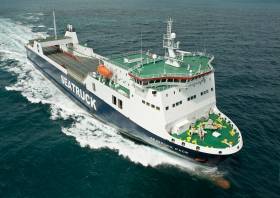Displaying items by tag: Larger Third Vessel
#LargerVessel – A larger third Seatruck Ferries ro-ro vessel will be added to the Dublin-Liverpool route today.
The current vessel, Clipper Ranger will be replaced by the larger and faster P series vessel, Seatruck Pace which will almost double the freight capacity with space for 110 trailers per sailing.
As reported on Afloat, Clipper Ranger was only added in mid-November 2015 but has already attracted significant flows of new traffic since its introduction.
The deployment of Seatruck Pace, a proven P series vessel as the third vessel to run alongside a pair of larger FSG vessels will ensure Seatruck offer three sailings daily in each direction to cope with continued growth on the central Irish Sea route.
The vessel switch is in direct response to demand and feedback from Seatruck customers and this has led to that tailored sailings schedule to reflect changing needs of the Irish market. Crucially it will add further capacity during the busy midweek period.
The 1,830 lane metre capacity Seatruck Pace will bring speed, schedule reliability, free height and even faster turnaround times in port. Drivers will now have single berth en-suite cabins and comfortable lounge area. In addition the ship benefits from a ramp interface to the lower hold in place of a lift.
Driver shortages are causing operators to reassess their traditional accompanied method. Seatruck Ferries believes in a switch to greater volumes of unaccompanied movements from ports, which reduces road mileage compared with the transit through Wales or Scotland.
As economic conditions improve, this addition is the next stage in Seatruck Ferries’ strategic development plan and complements the operators existing Warrenpoint-Heysham and Dublin-Heysham services.
























































